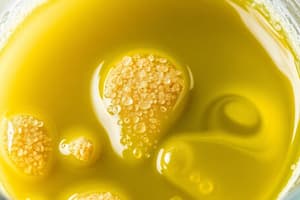Podcast
Questions and Answers
What is the main difference between a homogeneous and a heterogeneous mixture?
What is the main difference between a homogeneous and a heterogeneous mixture?
- Homogeneous mixtures have a fixed boiling point, while heterogeneous mixtures have variable boiling points.
- Homogeneous mixtures can be separated by physical means, while heterogeneous mixtures cannot.
- Homogeneous mixtures have uniform composition throughout, while heterogeneous mixtures do not. (correct)
- Homogeneous mixtures are made of a single substance, while heterogeneous mixtures are made of multiple substances.
Which method of separation is best suited for separating a liquid from a dissolved solid?
Which method of separation is best suited for separating a liquid from a dissolved solid?
- Centrifugation
- Evaporation (correct)
- Filtration
- Distillation
What property of substances is utilized in the distillation process to separate a mixture?
What property of substances is utilized in the distillation process to separate a mixture?
- Boiling point (correct)
- Density
- Electrical conductivity
- Solubility
In a solution, which component is referred to as the solvent?
In a solution, which component is referred to as the solvent?
Which method of separation is best suited for separating a solid from a liquid?
Which method of separation is best suited for separating a solid from a liquid?
What is the term used to describe the substance that is dissolved in a solution?
What is the term used to describe the substance that is dissolved in a solution?
Which of the following is a homogeneous mixture?
Which of the following is a homogeneous mixture?
What is the main difference between homogeneous and heterogeneous mixtures?
What is the main difference between homogeneous and heterogeneous mixtures?
Which of the following is a heterogeneous mixture?
Which of the following is a heterogeneous mixture?
What is the primary component of air, a homogeneous mixture?
What is the primary component of air, a homogeneous mixture?
How can a heterogeneous mixture like sand and oil in water be separated?
How can a heterogeneous mixture like sand and oil in water be separated?
What is the process called when a solid dissolves in a liquid to form a homogeneous mixture?
What is the process called when a solid dissolves in a liquid to form a homogeneous mixture?
Flashcards are hidden until you start studying
Study Notes
Mixtures
Mixtures can be defined as the combination of two or more components that do not react chemically with each other. They can be classified into two main categories based on their physical properties:
Homogeneous Mixtures
Homogeneous mixtures have uniform composition throughout the sample. This means that if you take any small portion from anywhere in the mixture, it will have the same composition. Examples of homogeneous mixtures are saltwater and air.
Types of Homogeneous Mixtures
Saltwater
Saltwater is formed when salt dissolves into water. The concentration of the salt can vary, but the overall ratio of salt to water remains constant.
Air
Air is made up of different gases including nitrogen (78.08%) and oxygen (21.00%). The remaining parts are argon, carbon dioxide, and smaller amounts of other gases like helium, hydrogen, methane, krypton, xenon, and neon.
Heterogeneous Mixtures
In contrast, heterogeneous mixtures have varying compositions within them. This means that if you take any small portion from anywhere in the mixture, it will not have the same composition. Examples of heterogeneous mixtures are sand and oil in water.
Types of Heterogeneous Mixtures
Sand and Oil in Water
Sand is a solid that does not dissolve in water. The oil floats on the surface because it has lower density than the sand or water.
Methods of Separating Mixtures
There are various methods to separate mixtures, depending on their properties:
Evaporation
Evaporation can be used for separating volatile liquids from solutions. When a liquid evaporates, particles turn into gas and rise. For example, alcohol can be separated from water by boiling the solution and collecting the vapor.
Filtration
Filtration involves passing a mixture through a filter which retains larger particles while smaller ones pass through. This method separates solids from liquids. Examples include coffee filters used at home or industrial filtration systems.
Distillation
Distillation uses heat to change the state of a substance from liquid to gas (evaporation) and back to liquid (condensation). Different substances have different boiling points. For instance, water boils at lower temperatures than alcohol. By heating a mixture, the liquid with the lowest boiling point evaporates first and condenses separately.
Solutions
Solutions are homogeneous mixtures where one component dissolves in another, resulting in a new substance called a solute. The component that does the dissolving is called the solvent. For example, sugar (solute) dissolved in water (solvent) forms a solution.
Studying That Suits You
Use AI to generate personalized quizzes and flashcards to suit your learning preferences.




